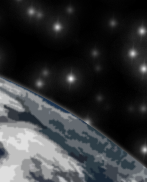|
3.1. Mercury

http://grin.hq.nasa.gov/IMAGES/SMALL/GPN-2000-000465.jpg
• It was first observed in 1610 by Galileo Galilei.
• We can observe this planet once in the morning or shortly after sunset, and because of that, people in the antiquity thought that Mercury was two planets: Apollo and Hermes.
• It is the first planet of the solar system counting from the Sun
• The rotation takes 58 Earth days;
• The translation takes 87 Earth days;
• Its temperature ranges from -173 ° C to 427 ° C;
• Its diameter is 4,879 km;
• Its distance from the Sun varies from 77 million kilometers to 46 million.
3.2. Venus

http://www.sentandoapua.com.br/4images/data/media/3/venus_galileo.jpg
• We can see Venus with the naked eye;
• It is known as Star of the Shepherd;
• It was considered as two planets in ancient times: Lucifer and Vesper;
• In the third century BC, Pythagoras discovered that it was only one planet.
Data from Venus:
• Rotation: -243 days (East / West)
• Translation: 224 days
• Diameter: 12 102 km
• Maximum temperature: 482 º C (900 º F)
• Atmospheric pressure: 92 bar
• Atmospheric Composition: Helium, Sodium, Oxygen, Carbon Dioxide, Sulfur and Water Vapor
3.3. Earth
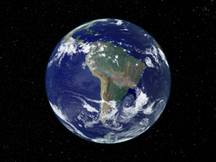
http://veimages.gsfc.nasa.gov/1929/sa_layered_day.jpg
• Good positioning in the Solar System;
• Water in the liquid state;
• Atmosphere is composed of: 78% nitrogen, 21% oxygen and 1% of other components;
• Moon is the only natural satellite;
• It is about 150 million km from the Sun, equivalent to 500 light-seconds;
• Has approximately ¾ of its surface formed by water.
Structure of the Earth
• Nucleus
The core is divided into solid and liquid core and is composed predominantly of iron and nickel. That part of the core is that it gives the formation of the magnetic field.
• Mantle
The mantle, which is part of the core and the crust is formed by silicon, magnesium and iron. This happens because of the highest temperatures around 3400°C.
• Crust
The crust or lithosphere is the outer part of the planet formed by oxygen, silicon, aluminum, magnesium and iron. These lithospheric or tectonic plates move slowly and continuously on the mantle. Such moves occur because of the pressures that the mantle exerts on the crust, leading to deformations in the crust. There happens also the disruption of its rock layers from the pressure of the mantle, causing the volcanism, which occurs mainly in regions where there is a meeting of tectonic plates, earthquakes and vibrations that are induced by movements of the lithospheric plates.
The Eartg and the moon
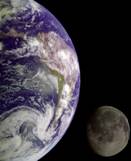
http://grin.hq.nasa.gov/IMAGES/SMALL/GPN-2000-001437.jpg
The magnetic field formed by the movement of electric charges in the nucleus, with the characteristics of atmosphere, gives conditions for the existence of life on the planet, because it protects against radiation from the sun and stars, and destroys the meteors before they reach the surface.
3.4. Mars
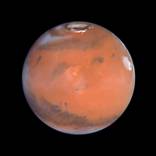
http://grin.hq.nasa.gov/IMAGES/LARGE/GPN-2000-000919.jpg
• Known as the Red Planet.
• Roman God of war - "The Red" – or the Greek god of war Ares -
• Candidate to have extra-terrestrial life.
• System of canyons - Valles Marineris.
• Atmosphere composed of Carbon Dioxide (CO2): 95.32% and other gases.
• The air of Mars contains 0.1% water in the air of the Earth
• Its two satellites were the names of the sons of Ares with Aphrodite: Phobos (fear) and Deimos (terror).
• The ancient people saw only a single star capable of competing with the red glow of Mars. It was a bright star in the constellation of Scorpio, which was known as Antares, or anti-air.
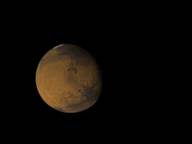
http://veimages.gsfc.nasa.gov/13695/marstc_still.0000_web.jpg
3.5. Jupiter
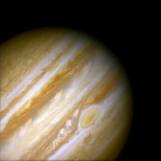
http://grin.hq.nasa.gov/IMAGES/SMALL/GPN-2000-000910.jpg
The fifth planet nearest the Sun and the largest in the solar system;
• If Jupiter was hollow, more than one thousand Earths fit inside;
• There is a ring system, which is very fragile and totally invisible from the Earth;
•Jupiter has 63 moons, but the main ones are: Europe: 3 days and 13 hours to give a complete turn around Jupiter, Io: 1 day, 19 hours, Callisto: 16 days and 17 hours and Ganymede: 7 days and 5 hours, they were seen by Galileo Galilei in 1610;
• Great Spot is a complex storm moving in a direction anti-clockwise;
• Jupiter has its hot core and releases the space to 3 times more energy than it receives from the Sun.
3.6. Saturn
Saturn and its Moon Titan

http://grin.hq.nasa.gov/IMAGES/SMALL/GPN-2002-000060.jpg
• Sixth planet of the Solar System, between Jupiter and Uranus, whose name comes from a Roman god, the god of time.
• Galileo Galilei was the first to observe Saturn in 1610.
• Has less density than water, with 0.7 g / cm³.
• The atmosphere of Saturn has a pattern of dark and light parts, like those of Jupiter, but less remarkable.
• Its rings consist essentially of a mixture of ice, dust and rock.
• They do not exceed 1.5 kilometers thick, but can reach hundreds of thousands of kilometers in diameter.
3.7. Uranus
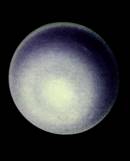
http://grin.hq.nasa.gov/IMAGES/SMALL/GPN-2000-000440.jpg
-
It is the seventh planet of the solar system and the third largest planet in the system.
-
Uranus has 15 moons. His largest moons are Titania and Oberon, discovered by William Herschel.
-
The duration of one day on Uranus is 17 hours and 14 minutes. And the translation last 84 years of the Earth. As the translation last 84 years, the seasons are very long, only the winter of Uranus lasts 21 years.
-
Uranus is the last planet that you can see, but it is often confused with a normal star. You can only see in places suitable for people with vision and very accurate, and with the help of a binocular.
-
It is 1.78 billion miles far away from the Sun.
-
The atmosphere of Uranus is made of 83% of hydrogen,15% of helium and 2% of small amounts of methane and acetylene and other hydrocarbons. Methane absorbs red light and so he has a greenish-blue color. Uranus is a gaseous planet, and many planets have colored bands as Uranus, but you can not see these bands because they are hidden by the layer of methane that is around it.
Uranus is composed of rocks and ice, plus a bit of hydrogen and helium.
-
In 1977 the first nine rings of Uranus was discovered. They were photographed and measured during the meetings of the Voyager (space probe launched by NASA in 1977). The rings of Uranus are different from those of Jupiter and Saturn. One of the rings, the epsilon of gray, is composed by blocks of ice. In addition, each ring has a different size, from millimeters to meters.
3.8. Neptune
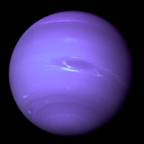
http://grin.hq.nasa.gov/IMAGES/SMALL/GPN-2000-000443.jpg
Neptune is the eighth planet of the solar system. According to Roman mythology he is the son of Saturn and brother of Jupiter and Pluto. Neptune is known as Poseidon, the god of the waters by Greek mythology.
The mass of Neptune is 1.02.1026 kg, the diameter is 49528 km and it is 4498252900 km far from the Sun. One day in Neptune last 16 hours.
It was discovered by Johann Gottfried Galle on September 23 of 1846. Its rotational period is 16.11 hours.
Neptune and Triton
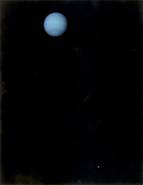
http://grin.hq.nasa.gov/IMAGES/SMALL/GPN-2000-000442.jpg
In 1989 the Voyager 2 passed by Neptune and discovered series of new information. Uranus and Neptune have a very similar composition. They have a mantle of liquid hydrogen, and its atmosphere is formed by a combination of ammonia, helium, and methane. And their color is blue because of the presence of methane.
Neptune has a set of rings bit dense and composed of small particles. The main rings are: Adams, Galle and Le Verrier. The names of its main rings were given as tributes to the astronomers who discovered them.
|
